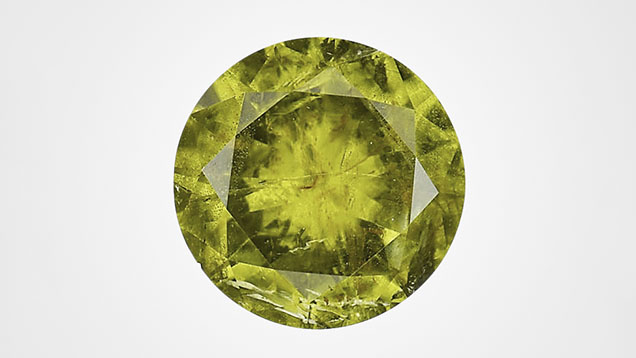Large Faceted Pallasitic Peridot


Peridot, the green gem variety of the mineral olivine, is a relatively common gemstone known for forming as irregular nodules in lava flows or as large crystals within pockets of solidified rock throughout many areas of the world. Rarely, this stone can also be sourced from stony iron meteorites that have survived their flaming passage through Earth’s atmosphere. These peridot-containing meteorites are known as pallasite, and the gems they contain are known as pallasitic peridot. Due to the extreme conditions endured by extraterrestrial stones, examples of faceted pallasitic peridot usually weigh less than half a carat (A.H. Shen et al., “Identification of extraterrestrial peridot by trace elements,” Fall 2011 G&G, pp. 208–213). A recent submission to the Carlsbad laboratory saw the largest client-submitted example to date at 2.32 ct (figure 1). The gem possessed characteristic inclusions such as thin, stacked red platelets (figure 2, left) and coarse, high-relief fingerprints (figure 2, right).

At GIA, extraterrestrial peridot is distinguished from the terrestrial variety by either energy-dispersive X-ray fluorescence or laser ablation–inductively coupled plasma–mass spectrometry (LA-ICP-MS) analysis of the trace elements vanadium, lithium, nickel, manganese, zinc, and cobalt (Shen et al., 2011). LA-ICP-MS analysis of these elements in the stone was diagnostic of pallasitic peridot when compared to published terrestrial and extraterrestrial data (Shen et al., 2011) (table 1).
Pallasite is named in honor of geologist Peter Simon Pallas, who first documented a stony iron meteorite with “rounded and elongated drops of a very brittle but hard, amber-yellow, transparent glass” discovered in Krasnoyarsk, Siberia, in 1749. At the time, suggestion of an extraterrestrial origin was daring. However, this theory gained support, and by 1794 additional scientific publications accepted the idea (J. Sinkankas et al., “Peridot as an interplanetary gemstone,” Spring 1992 G&G, pp. 43–51). Today, pallasite is believed to have formed within asteroids containing an iron-nickel core and a silicate mantle (R.T. Dodd, Meteorites: A Petrologic-Chemical Synthesis, Cambridge University Press, Cambridge, UK, 1981, 368 pp.).
.jpg)


